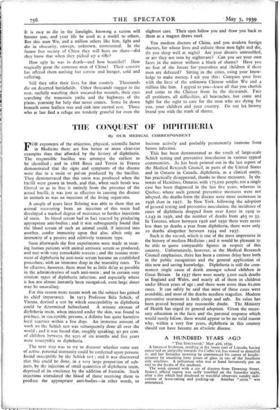THE CONQUEST OF DIPHTHERIA
By OUR MEDICAL CORRESPONDENT
FOR exponents of the objective, physical, scientific factor in Medicine there are few better or more clear-cut examples than that afforded by the history of diphtheria. The responsible bacillus was amongst the earliest to be identified ; and in 1888 Roux and Yersin in France demonstrated that the signs and symptoms of the disease were due to a toxin or poison produced by the bacillus. They demonstrated that this toxin was produced when the bacilli were grown in broth, and that, when such broth was filtered so as to free it entirely from the presence of the actual bacilli, it was just as effective in causing the disease in animals as was an injection of the living organisms.
A couple of years later Gehring was able to show that an animal recovering from an injection of this toxin had developed a marked degree of resistance to further injections of toxin. Its blood serum had in fact reacted by producing appropriate anti-bodies ; and it was subsequently found that the blood serum of such an animal could, if injected into another, confer immunity upon that also, albeit only an immunity of a passive and relatively transient type.
Soon afterwards the first experiments were made m treat- ing human patients with animal antitoxic serum so produced, and met with very remarkable success ; and the routine treat- ment of diphtheria by anti-toxic serum became an established procedure, with an immense drop in the mortality rates. To be effective, however, there must be as little delay as possible in the administration of such anti-toxin ; and in certain very virulent types of diphtheria infection, and especially where it has not almost instantly been recognised, even large doses may be unavailing.
For this reason more recent work on the subject has gained its chief importance. In 1913 Professor Bela Schick, of Vienna, devised a test by which susceptibility to diphtheria could be determined beforehand. A minute amount of diphtheria toxin, when injected under the skin, was found to produce, in susceptible persons, a definite but quite harmless local reaction within a few days. An immense amount of work on the Schick test was subsequently done all over the world ; and it was found that, roughly speaking, 90 per cent. of children between the ages of six months and five years were susceptible to diphtheria.
The next step was to try to discover whether some sort of active, personal immunity could be conferred upon persons found susceptible by the Schick test ; and it was discovered that this could be done, in a very large proportion of sub- jects, by the injection of small quantities of diphtheria toxin, deprived of its virulence by the addition of formalin. Such injections stimulated the blood of those receiving them to produce the appropriate anti-bodies—in other words, to become actively and probably permanently immune from future infection.
This has been demonstrated as the result of large-scale Schick testing and preventive inoculation in various typical communities. As has been pointed out in the last report. of the Medical Research Council, in parts of the United States and in Ontario in Canada, diphtheria, as a clinical entity, has practically disappeared, thanks to these measures. In the towns of Hamilton, Ontario, with 175,000 people, not a single case has been diagnosed in the last five years, whereas in Quebec, where such general preventive measures were not adopted, the deaths from the disease were more numerous in 1936 than in 1927. In New York, following the adoption of general testing and preventive inoculation, the incidence of cases of diphtheria dropped from over 8,000 in 1929 to 1,143 in 1936, and the number of deaths from 463 to 35. In Toronto, where between 1926 and 193o there were never less than 5o deaths a year from diphtheria, there were only o deaths altogether between 1934 and 1937.
Such is the record, which is one of the most impressive in the history of modern Medicine ; and it would be pleasant to be able to quote comparable figures in respect of this country. Unfortunately, however, as the Medical Research Council emphasises, there has been a curious delay here both in the public recognition and the general application of this new and saving knowledge. Diphtheria is still the com- monest single cause of death amongst school children in Great Britain. In 1937 there were nearly 3,000 such deaths in England and Wales, and nearly all of them in children under fifteen years of age ; and there were more than 61.,00o cases. It can safely be said that most of these cases were avoidable, and most of the deaths needless tragedies. Modern preventive treatment is both cheap and safe. Its value has been proved beyond any reasonable doubt. The Ministry of Health has urged its general adoption. Given the neces- sary education in the facts and the parental response which would surely follow, there would appear to be no valid reason why, within a very few years, diphtheria in this country should not have become an obsolete disease.














































 Previous page
Previous page